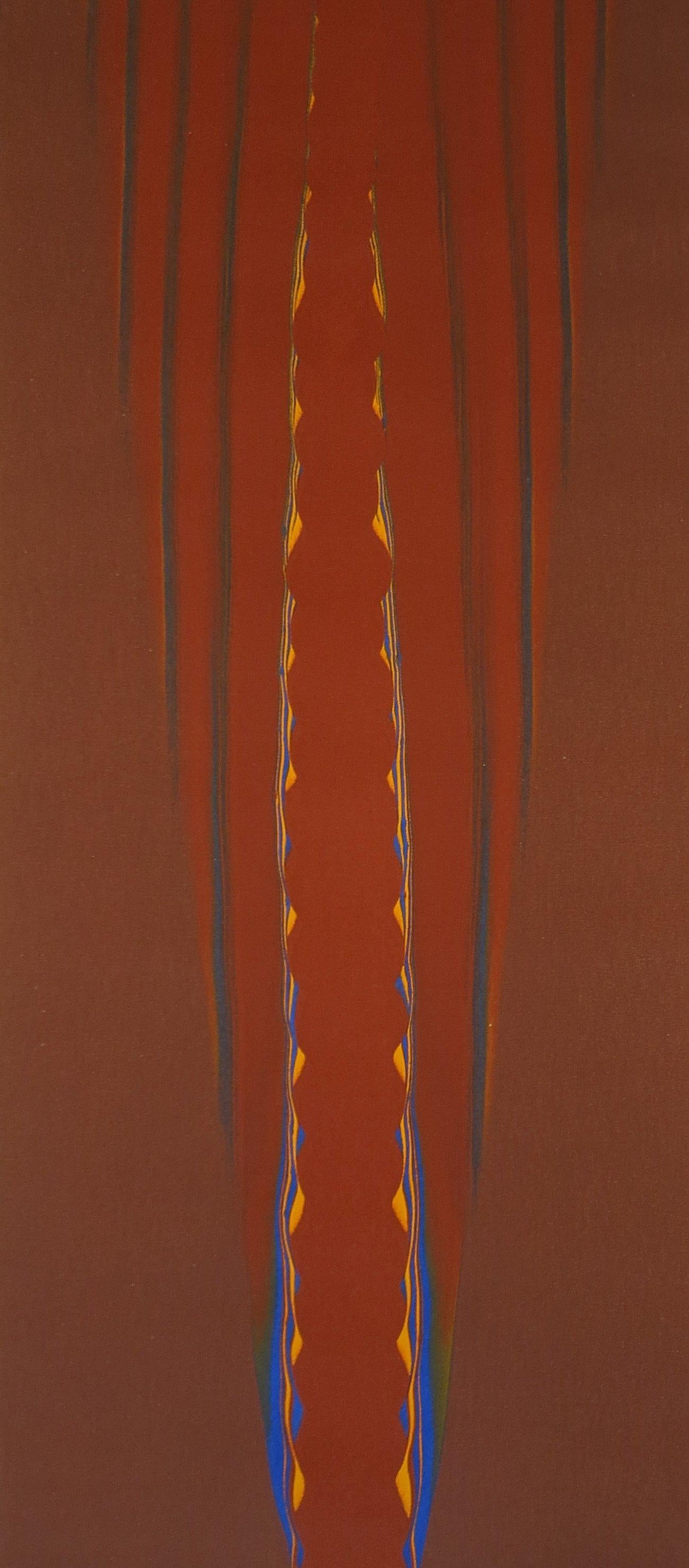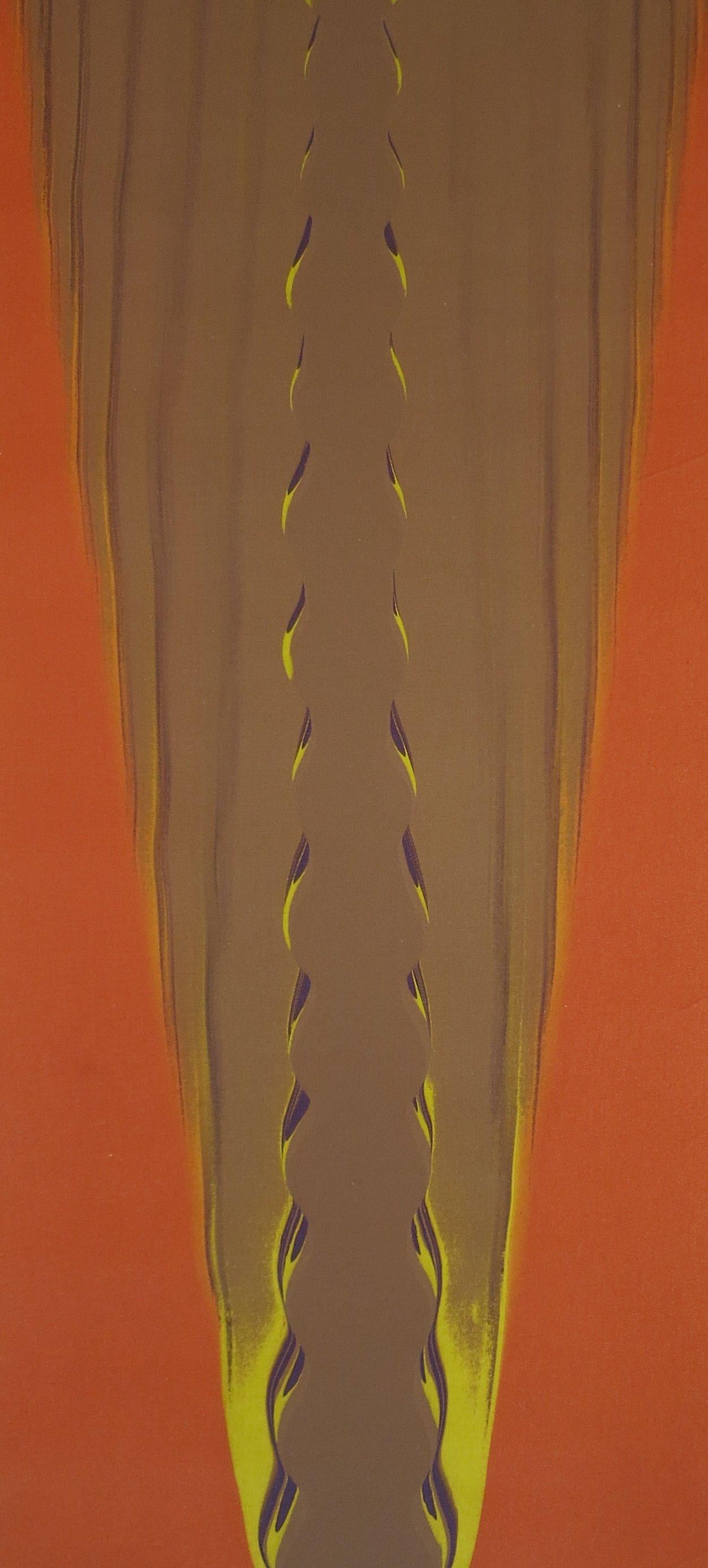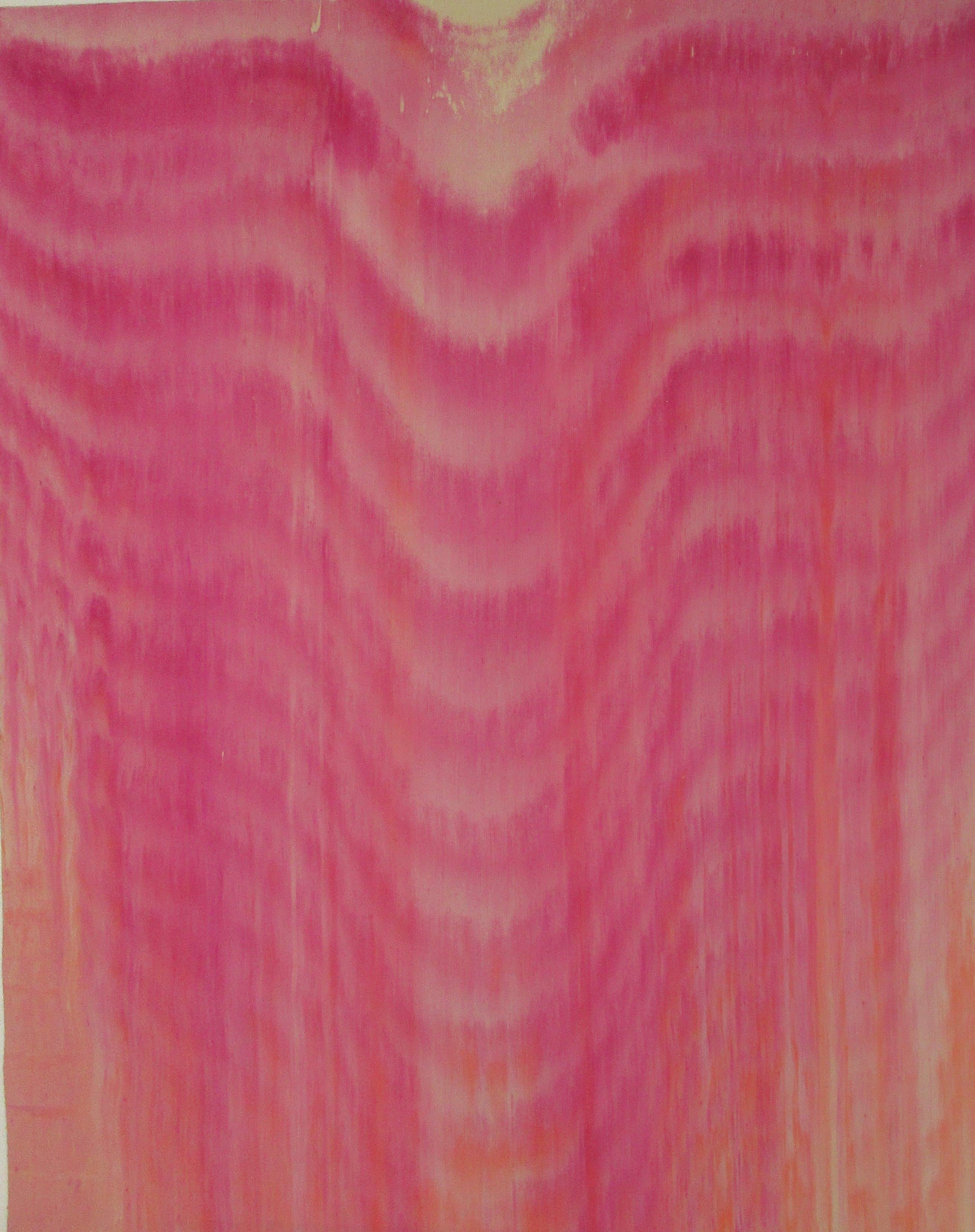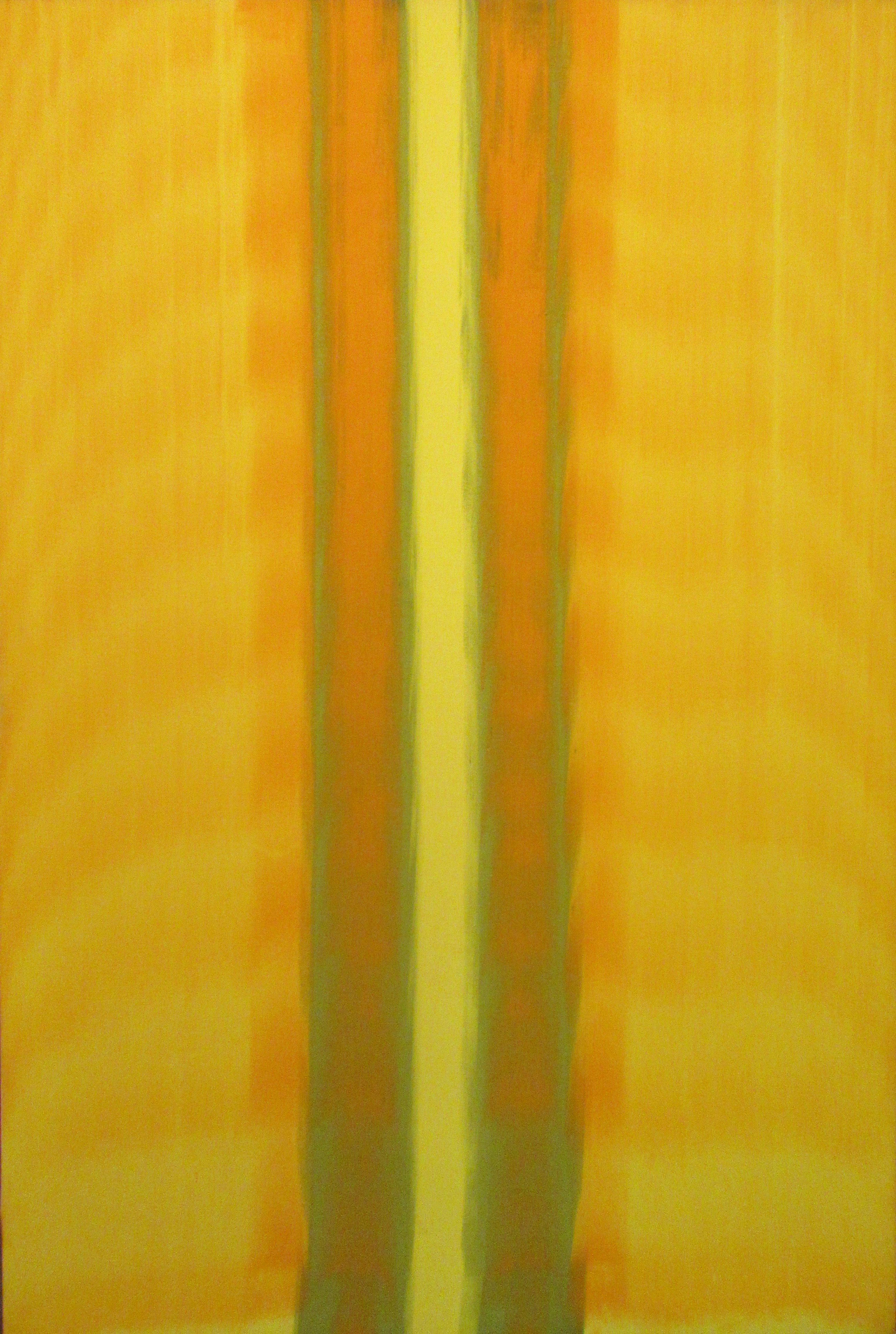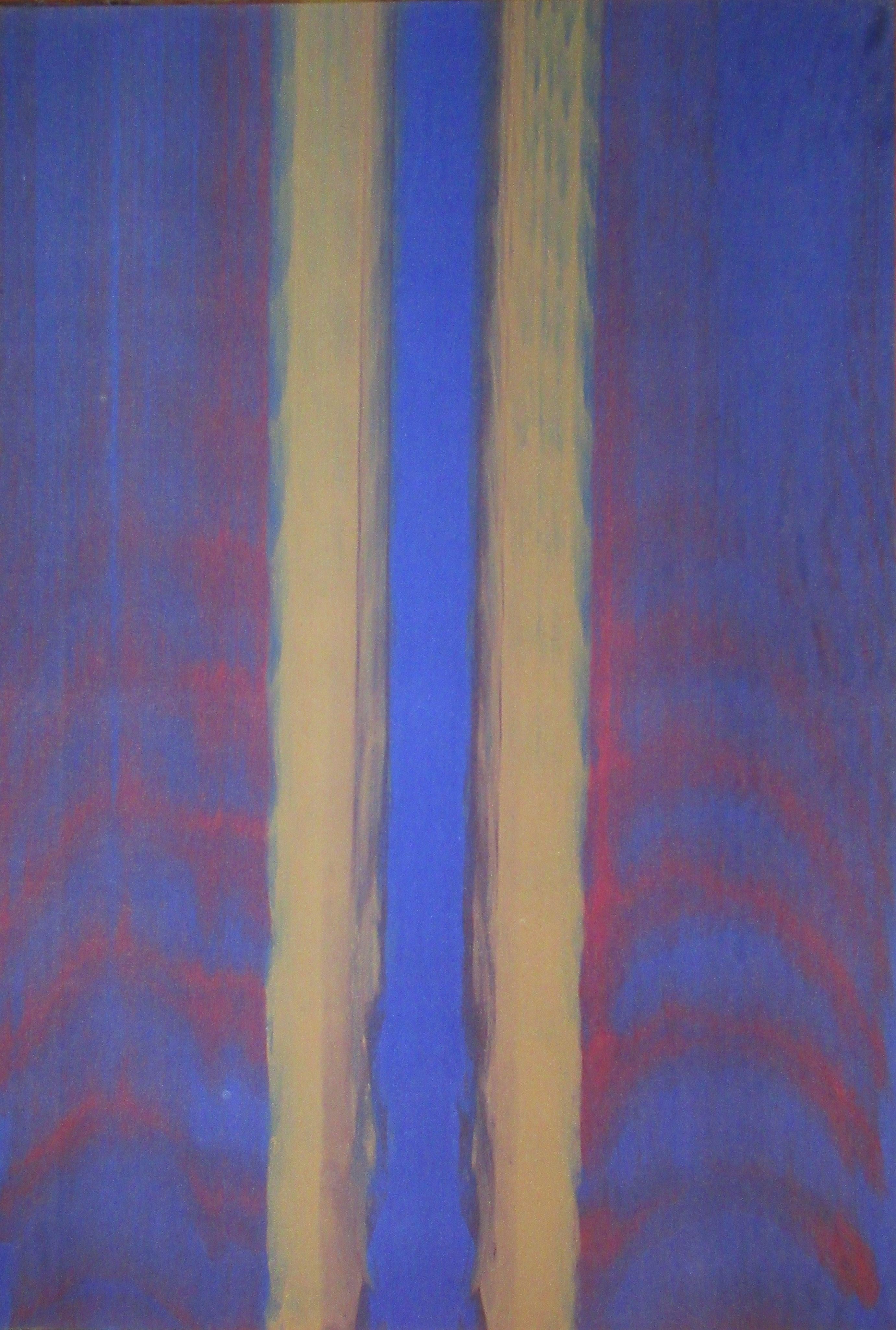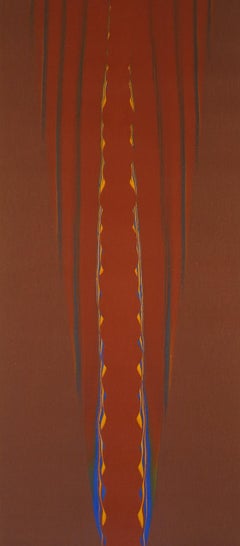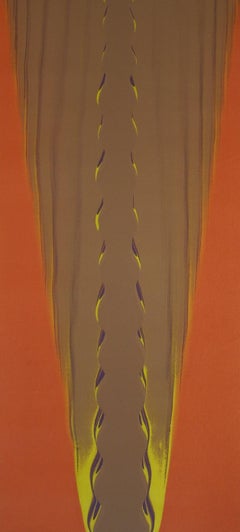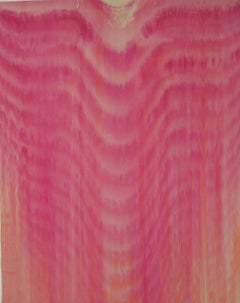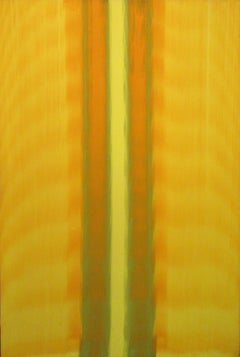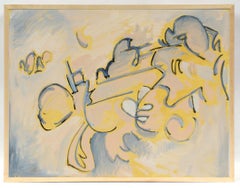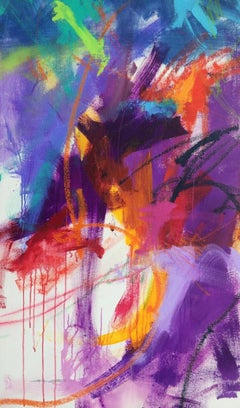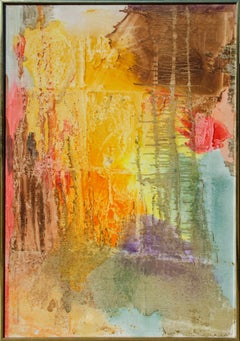Items Similar to "Untitled" Gene Hedge, Abstract Color Field, Purple Orange Blue Midcentury Work
Want more images or videos?
Request additional images or videos from the seller
1 of 4
Gene Hedge"Untitled" Gene Hedge, Abstract Color Field, Purple Orange Blue Midcentury Workcirca 1970
circa 1970
$8,000
£6,066.39
€7,019.09
CA$11,308.29
A$12,606.57
CHF 6,574.85
MX$152,442.67
NOK 82,649.03
SEK 78,202.50
DKK 52,390.37
About the Item
Gene Hedge
Untitled, circa 1970
Acrylic on canvas
48 x 18 inches
Provenance
Estate of the artist
Gene Hedge was born (1928) and raised in rural Indiana. After military service, he briefly attended Ball State University in Muncie, Indiana. There he encountered the writing of Laszlo Moholy-Nagy, and the following year (1949) went to study at the Institute of Design in Chicago. He received a B.S. degree in Visual Design from the Institute of Design (1953), and he also took courses at the Art Institute of Chicago and began working in collage.
During this period, the influence of Eugene Dana (painter 1912-1996), Aaron Siskind (photographer 1903-1991), and Robert Nickle (designer & collagist 1919-1980) became especially important, first as teachers at the Institute of Design and later as friends. At the School of the Art Institute of Chicago, Hedge became involved with the Exhibition Momentum group of young artists, exhibiting his collages in the 1954 show.
Picked-up by Allan Frumkin Gallery in Chicago, Hedge soon began to show his distinctive collage-paintings in group shows around the United States including the Carnegie International exhibition in Pittsburgh (1955) and the Art Institute of Chicago (1956). It was in this year that Hedge relocated to New York City.
His work was then included in the New Talent/Art in America at New York City’s Rockefeller Center (1959), Contemporary American Painting at the Whitney Museum of American Art (1963), Collage in America at the Museum of Modern Art (1966), 100 Years: 100 Artists at Art Institute of Chicago (1979). Hedge was represented by B.C. Holland Gallery (Chicago) and the Poindexter Gallery (New York), and he also showed at the Stable Gallery (New York) and other galleries and museums across the United States.
In the early 1970s, Hedge began traveling to explore new landscapes, art and architecture, especially that of the Southwestern United States, the Middle-East, and India. During these often-lengthy journeys, he photographically documented all that he was experiencing visually. Having formally studied multiple artistic disciplines, Hedge expanded his work exploring new painting techniques and lithography.
From an early age, Hedge observed an asymmetrical order to natural objects like fruit, fish, feathers, or seashells. Using macro-digital photography and large format printmaking, Hedge’s work provides a viewer with a sense of joy and wonder through un-manipulated images of natural visual organizations normally unseen by the human eye.
Gene Hedge taught students and teachers and developed educational programs in design at the School of Design, North Carolina State University, Raleigh, N.C. (1968 -1973), and the University of Illinois at Chicago (1980-1986).
- Creator:Gene Hedge (1928 - 2017, American)
- Creation Year:circa 1970
- Dimensions:Height: 48 in (121.92 cm)Width: 18 in (45.72 cm)
- More Editions & Sizes:Unique WorkPrice: $8,000
- Medium:
- Movement & Style:
- Period:
- Framing:Framing Options Available
- Condition:
- Gallery Location:New York, NY
- Reference Number:1stDibs: LU1841216046262
About the Seller
5.0
Platinum Seller
Premium sellers with a 4.7+ rating and 24-hour response times
Established in 2022
1stDibs seller since 2022
119 sales on 1stDibs
Typical response time: <1 hour
- ShippingRetrieving quote...Shipping from: New York, NY
- Return Policy
Authenticity Guarantee
In the unlikely event there’s an issue with an item’s authenticity, contact us within 1 year for a full refund. DetailsMoney-Back Guarantee
If your item is not as described, is damaged in transit, or does not arrive, contact us within 7 days for a full refund. Details24-Hour Cancellation
You have a 24-hour grace period in which to reconsider your purchase, with no questions asked.Vetted Professional Sellers
Our world-class sellers must adhere to strict standards for service and quality, maintaining the integrity of our listings.Price-Match Guarantee
If you find that a seller listed the same item for a lower price elsewhere, we’ll match it.Trusted Global Delivery
Our best-in-class carrier network provides specialized shipping options worldwide, including custom delivery.More From This Seller
View All"Untitled" Gene Hedge, Abstract Color Field, Red Blue Orange Midcentury Painting
Located in New York, NY
Gene Hedge
Untitled, circa 1970
Acrylic on canvas
48 x 18 inches
Provenance
Estate of the artist
Gene Hedge was born (1928) and raised in rural Indiana. After military service, he...
Category
1970s Color-Field Abstract Paintings
Materials
Canvas, Acrylic
"Untitled" Gene Hedge, Abstract Color Field, Red Blue Green Midcentury Painting
Located in New York, NY
Gene Hedge
Untitled, circa 1970
Acrylic on canvas
48 x 18 inches
Provenance
Estate of the artist
Gene Hedge was born (1928) and raised in rural Indiana. After military service, he...
Category
1970s Abstract Abstract Paintings
Materials
Canvas, Acrylic
"Untitled" Gene Hedge, Abstract Color Field, Pink Midcentury Bauhaus Painting
Located in New York, NY
Gene Hedge
Untitled, 1966
Acrylic on canvas
60 x 43 inches
(P276)
Gene Hedge was born (1928) and raised in rural Indiana. After military service, he briefly attended Ball State Univ...
Category
1960s Abstract Abstract Paintings
Materials
Canvas, Acrylic
"Untitled" Gene Hedge, Abstract Color Field, Yellow Midcentury Painting
Located in New York, NY
Gene Hedge
Untitled, circa 1966
Acrylic on canvas
61 1/2 x 42 1/8 inches
(P122)
Gene Hedge was born (1928) and raised in rural Indiana. After military service, he briefly attended Ball State University in Muncie, Indiana. There he encountered the writing of Laszlo Moholy-Nagy, and the following year (1949) went to study at the Institute of Design in Chicago. He received a B.S. degree in Visual Design from the Institute of Design (1953), and he also took courses at the Art Institute of Chicago and began working in collage.
During this period, the influence of Eugene Dana...
Category
1960s Abstract Abstract Paintings
Materials
Canvas, Acrylic
"Inside Blue" Gene Hedge, Abstract Color Field, Bauhaus Midcentury Painting
Located in New York, NY
Gene Hedge
Inside Blue, 1966
Acrylic on canvas
61 1/4 x 43 3/4 inches
(P124)
Gene Hedge was born (1928) and raised in rural Indiana. After military service, he briefly attended Ball State University in Muncie, Indiana. There he encountered the writing of Laszlo Moholy-Nagy, and the following year (1949) went to study at the Institute of Design in Chicago. He received a B.S. degree in Visual Design from the Institute of Design (1953), and he also took courses at the Art Institute of Chicago and began working in collage.
During this period, the influence of Eugene Dana...
Category
1960s Abstract Abstract Paintings
Materials
Canvas, Acrylic
"Emblem" Gene Hedge, Abstract Color Field, Black Midcentury Bauhaus Painting
Located in New York, NY
Gene Hedge
Emblem, 1976
Acrylic on canvas
19 1/2 x 58 1/2 inches
(P063)
Gene Hedge was born (1928) and raised in rural Indiana. After military service, he briefly attended Ball Stat...
Category
1970s Abstract Abstract Paintings
Materials
Canvas, Acrylic
You May Also Like
Abstract Expressionist Painting American Late 1970's Mid Century Orange Purple
Located in Buffalo, NY
Mid Century Modern, American Abstract Expressionist Painting on artist board.
This wonderful work combines unique shades of orange yellow and purple and comes house in a contemporar...
Category
1970s Abstract Expressionist Abstract Paintings
Materials
Masonite, Acrylic
$551 Sale Price
20% Off
C.E. Ross, "Harlequin", Colorful Purple Blue Orange Pink Abstract Painting
By Charles Emery Ross
Located in Saratoga Springs, NY
This colorful abstract painting, "Harlequin", by artist Charles Emery Ross is a 46x28 acrylic painting on canvas featuring bold brush strokes and drips of vibrant color. Blue, purple...
Category
2010s Abstract Abstract Paintings
Materials
Canvas, Acrylic
$3,080 Sale Price
20% Off
Homage to Color Purple
By Susan Moss
Located in Santa Monica, CA
Oil on birch panel.
Category
2010s Abstract Impressionist Abstract Paintings
Materials
Birch, Oil
$1,600 Sale Price
20% Off
Colorful 1970s Abstraction, Signed "Soyer" Illegibly
Located in New York, NY
Sloyer
Untitled, 1976
Oil on canvas
36 1/4 x 24 x 1 3/8 in.
Artist label verso (text slightly obscured)
Signed on stretcher bar
Category
1970s Abstract Abstract Paintings
Materials
Canvas, Oil
Early Abstract Art Purple Orange & Yellow on White Background by British Artist
By Angela Wakefield
Located in Preston, GB
A rare early career experimental abstract artwork using Purple, Orange & Yellow on a White Background, by leading Contemporary British Artist, Angela Wakefield.
Art measures 20 x 18 inches
Frame measures 24 x 22 inches
An original painting. Acrylic on canvas. This can be hung in any orientation, portrait or landscape
Angela Wakefield has twice been on the front cover of ‘Art of England’ and featured in ARTnews, attracting international attention and critical acclaim with her urban landscape paintings of New York & London. The style of painting has been described as ‘contemporary realism’, and is often favourably compared with Edward Hopper by collectors and art critics. Angela’s work is held in private collections in Europe and the USA, including the British Royal Family. Her admirers include leading figures in international business, filmmaking and the media.
PROVENANCE: Ascot Studios...
Category
Early 2000s Abstract Expressionist Abstract Paintings
Materials
Canvas, Acrylic, Watercolor, Cotton, Wood, Cotton Canvas
Red, Orange, Blue, Purple
By Raymond Parker
Located in San Francisco, CA
Artist: Raymond Parker – American (1922-1990)
Title: Red, Orange, Blue, Purple
Year: 1969
Medium: Color Lithograph
Sight size: 22.25 x 30 inches.
Sheet size: 22.25 x 30 inches
Sig...
Category
1960s Abstract Expressionist Abstract Prints
Materials
Color, Lithograph
